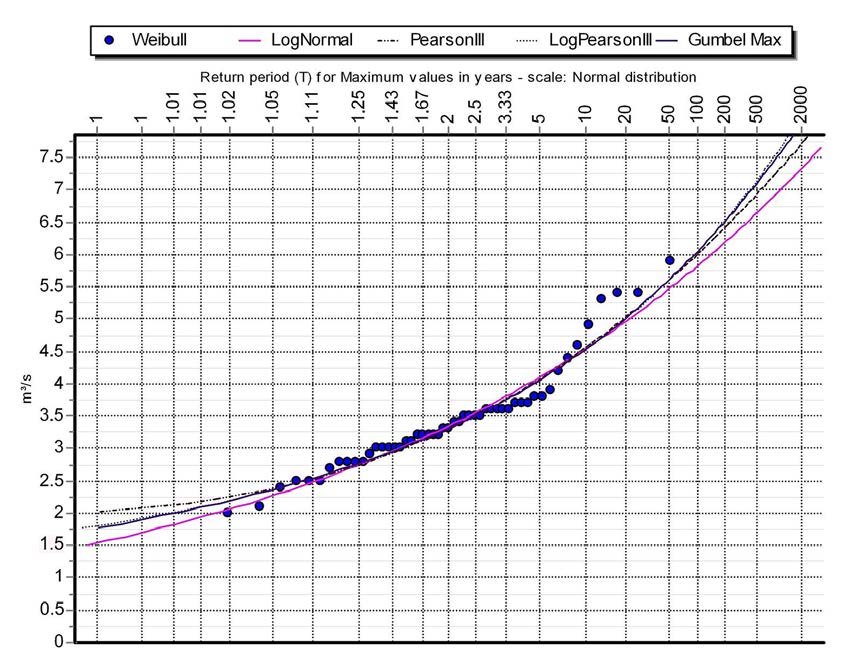Estimation of maximum annual discharges by frequency analysis with four probability distributions in case of non-homogeneous time series (Kazani karst spring in Republic of Macedonia)
DOI:
https://doi.org/10.3986/ac.v45i3.1544Keywords:
karst spring, annual maximum discharge, hydrology, homogeneity, frequency analysisAbstract
Frequency analysis is usually used in hydrology for the possibility and scale of discharge extremes, especially low flows or flood features of concrete gauge. The paper presents a frequency analysis carried out on a 51 year period (1961-2011) series of maximum annual discharge, on Kazani karst spring gauge station. The time series were non-homogenous according to Cumulative deviations test (Q = 1.531) and Standard normal homogeneity test ( = 10.543). After adjusting of annual maximum discharges (AMD) before the year of change (1995), with using AnClim software, the frequency analysis was made using four probability distributions. Obtained results show possibility of karst spring flood occurrence for different return periods. After their calculation the best fitting distribution was chosen using graphical and statistical testing between empirical and theoretical data distribution. According to the spring significance for nature and humanity, it was crucial to choose a right probability distribution for annual maximum discharges of Kazani karst spring. Therefore, a comparison using graphical and statistical testing (Kolmogorov-Smirnov, χ2 and Anderson-Darling test) was made. The best fit according to three tests was the Gumbel distribution with AMD of 4.54 m3/s for return period of 10 years, 6.06 m3/s for return period of 100 years and 7.56 m3/s for return period of 1000 years, respectively.
Key words: karst spring, annual maximum discharge, hydrology, homogeneity, frequency analysis.
Ocena maksimalnih letnih pretokov s frekvenčno analizo s štirimi verjetnostnimi porazdelitvami v primeru nehomogenih časovnih serij (kraški izvir Kazani v Republiki Makedoniji)
Običajno uporabljamo v hidrologiji frekvenčno analizo za oceno verjetnosti in velikosti ekstremnih pretokov, še posebej nizkih tokov ali poplavnih značilnosti na določenih merilnih mestih. V članku je predstavljena frekvenčna analiza, ki je bila izvedena na seriji maksimalnih letnih pretokov izmerjenih na merilni postaji na kraškem izviru Kazani v obdobju 51 let (1961-2011). Glede na rezultate testa kumulativnih odklonov (Q = 1,531) in testa SNHT ( = 10,543) je časovna serija nehomogena. Po prilagoditvi letnih maksimalnih pretokov pred letom spremembe (1995) z uporabo programske opreme AnClim je bila izvedena frekvenčna analiza z uporabo štirih verjetnostnih porazdelitev. Dobljeni rezultati kažejo na verjetnost pojava poplav na kraškem izviru za različne povratne dobe. Po izračunu so bile z uporabo grafičnih in statističnih primerjav med empirično in teoretično razporeditvijo podatkov določene porazdelitve z najboljšim ujemanjem. Ker je izvir naravna vrednota in pomemben vir za družbo, je zelo pomembno izbrati ustrezno verjetnostno porazdelitev za maksimalne letne pretoke kraškega izvira Kazani. Zato je bila izvedena primerjava z uporabo grafičnih in statističnih testov (Kolmogorov-Smirnov, χ2 in Anderson-Darling). Najboljše ujemanje glede na te tri teste je bilo doseženo pri Gumbelovi porazdelitvi z maksimalnim letnim pretokom 4,54 m3/s za povratno dobo 10 let, 6,06 m3/s za povratno dobo 100 let in 7,56 m3/s za povratno dobo 1000 let.
Ključne besede: kraški izvir, maksimalni letni pretok, hidrologija, homogenost, frekvenčna analiza.
Downloads

Downloads
Published
How to Cite
Issue
Section
License
Authors guarantee that the work is their own original creation and does not infringe any statutory or common-law copyright or any proprietary right of any third party. In case of claims by third parties, authors commit their self to defend the interests of the publisher, and shall cover any potential costs.
More in: Submission chapter




